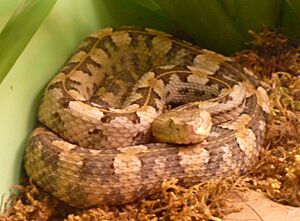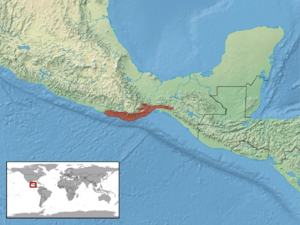Porthidium dunni facts for kids
Quick facts for kids Porthidium dunni |
|
|---|---|
 |
|
| Conservation status | |
| Scientific classification | |
| Genus: |
Porthidium
|
| Species: |
dunni
|
 |
|
| Synonyms | |
|
|
The Porthidium dunni is a type of snake often called Dunn's hognosed pitviper. It is a venomous snake belonging to the Viperidae family. This snake lives only in Mexico. Scientists do not recognize any different types or subspecies of this snake.
Contents
Why is it Called Dunn's Hognosed Pitviper?
This snake is named dunni to honor an American scientist. His name was Emmett Reid Dunn. He was a herpetologist, which means he studied reptiles and amphibians. The snake was named after him to thank him for his important work on snakes in America.
What Does Dunn's Hognosed Pitviper Look Like?
Adult Dunn's hognosed pitvipers are usually about 30 to 40 centimeters (12 to 16 inches) long. The longest one ever found was about 57 centimeters (22 inches) long. This snake is somewhat thick-bodied. It lives on the ground. The tip of its nose points slightly upwards.
Where Does Dunn's Hognosed Pitviper Live?
Porthidium dunni is found in southern Mexico. It lives in the lowlands along the Pacific coast. You can find it in the states of Oaxaca and western Chiapas. The first place this snake was officially found was near the village of Tehuantepec in Oaxaca.
What Kind of Place Does it Live In?
The Dunn's hognosed pitviper prefers to live in forest areas. This is its natural habitat.
Reproduction and Life Cycle
Porthidium dunni reproduces in a special way. It is ovoviviparous. This means the mother snake carries her eggs inside her body. The eggs hatch inside her. Then, she gives birth to live baby snakes.
How is Dunn's Hognosed Pitviper Protected?
The IUCN Red List of Threatened Species lists Porthidium dunni as "Least Concern" (LC). This is a good thing! It means the snake is not currently in danger of disappearing. Species are listed as Least Concern when they are found over a wide area. They also have a large population. Or, their numbers are not dropping quickly enough to be a big worry. The number of these snakes seems to be stable. This assessment was made in 2007.


